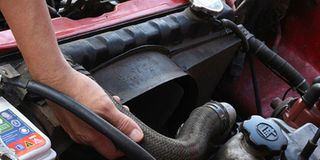Why does my car overheat?

A car might overheat because the cooling system is faulty. However, if checked and no problem is found, you will also need to check the thermostat. Below, a BMW X5. FILE PHOTO
Hello Paul, I am a regular reader of your helpful articles in My Car magazine. I drive a Toyota Harrier which of late overheats after I start driving. My mechanic has checked the engine radiator and cooling fan and they are in a good working condition. There is no leakage of coolant. However, the engine temperature quickly climbs to 95 degrees centigrade as I drive. What can we check?
Ivan. M
Hello Ivan, your mechanic has followed the right search curve but he needs to go further and inspect the engine thermostat.
A thermostat is a heat sensitive stop valve which is designed to allow or restrict coolant fluid flow. The thermostat action maintains the minimum operating temperature of a vehicle engine which ranges between 85-95 degrees centigrade on different engines. When you cold start your engine, coolant is kept within the engine by the thermostat until the engine temperature reaches the specified opening point.
Thereafter, the thermostat releases coolant to flow through the radiator and back in-order to cool the engine. Signs of thermostat failure include a quick rise of engine temperature above the normal range despite the normal operation of the engine cooling fans and absence of coolant leakage from the engine, radiator or water pump. Another sign of thermostat failure is the tendency to build pressure in the coolant hoses, especially the one delivering coolant fluid to the thermostat from the radiator. Your mechanic should also test the thermostat by dropping it in boiling water to confirm whether its spring valve releases. Always replace a worn out thermostat with a correct new one from a genuine Toyota parts dealer. Do not be tempted to do away with the thermostat. Running an engine without the thermostat can cause damage to metallic components of the engine cylinder head and piston block due to uneven heating and cooling. When you remove the thermostat permanently you will cause the engine to run hot all the time as the engine computer assumes that it is cold. This causes poor fuel economy, increased emissions, poor performance as the fuel air ratio is uneven and damage of spark plugs.
Paul, I drive a BMW X5 E70. Recently, my automatic transmission started to have shifting difficulty when I accelerate uphill or try to overtake. In extreme cases, it seems to select neutral when I accelerate. What do you advise me to do.
Henry
Henry, it would be useful to know the mileage of your BMW E70. Should it be in excess of 100,000 kms then you ought to consider servicing the transmission. This involves replenishing the transmission fluid (using a gearbox oil specified in the user manual) after replacing the transmission filter and pan gasket.
Many BMW owners overlook the service of their automatic transmissions because of the misleading claim that these transmissions have ‘’lifetime oil’’. In actual sense by lifetime BMW probably means the first five years of the car with its first owner.
When you inherit a used BMW (or any other vehicle) with a mileage in excess of 100,000 kms it is prudent to carry out a gearbox service. In your case, you also need to rule out mechanical or electrical failure of your automatic transmission.
A look at a sample of the gearbox oil to ascertain whether it smells burnt or has gearbox clutch or metallic debris will help rule out mechanical damage.
A computer diagnosis with a qualified repair technician will quickly establish whether your gearbox has suffered mechanical, hydraulic or electrical failure.
Should the diagnostic test show no major fault, then the BMW repair technician can proceed to service the gearbox as per BMW gearbox service guidelines.
Paul, as I drive my Toyota Nadia on a road with uneven surface I hear a knocking noise coming from the left front wheel. My mechanic has checked the CV joints and replaced the front shock absorbers. The noise usually stops if there is someone seated in the co-driver’s seat but comes back when there is no one.
Mutungi. G
Hello, you ought to ask your mechanic to check the sway (stabiliser) bar mounts or link bars. When they wear out they can cause such noise. Also inspect the front shock absorber mounting bearing plates and look out for wear or excessive play.
It is also necessary to check the lower inner suspension plate bushes. These usually wear out at mileages in excess of 100,000 kms. When they tear, they can cause the rattle that you have heard. This should catch the problem.
Ask the mechanic
By Paul Kaganzi
0772316145
send sms: mycar (space) your comments and questions to 6933, or email them to [email protected]




